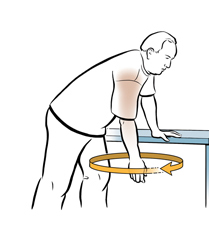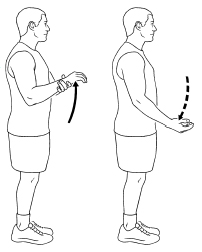Arthroscopic Shoulder Surgery
MEDICATION & ICING:
PAIN MEDICATION: You may or may not have gotten a nerve block for your operative shoulder prior to procedure. Regardless, make sure you are taking Norco hydrocodone (10/325mg) two tablets by mouth every 6-8 hours for pain as scheduled for at least the first 3 days post-operatively. It's important to stay on top of your pain and take it scheduled.* At post-operative day #4, you can begin to wean off this medication and taking it as needed. Eventually, you can transition to Tylenol Extra Strength 500mg, available over the counter. We prefer that you do not take NSAIDS for the first 6-8 weeks including Ibuprofen, Motrin, Advil, Aleve, etc.
CONSTIPATION: Miralax or Colace (stool softener/laxative) is highly recommended and available over the counter. One of the most common side effect of Norco or narcotic medication is constipation, so start taking this postoperatively as instructed on label.
NAUSEA: Another common side effect of general anesthesia and Norco is nausea. If feeling nauseous, please take the prescribed Phenergan 25mg, 1 tab by mouth every 8 hours as needed.
ICE REGULARLY: Please ice your shoulder regularly, meaning 20 minutes on, 20 minutes off during your waking hours, for the first 3-7 days post-operatively. If you purchased a "cryocuff" which is a cuff that wraps around your shoulder and circulates water with a cooler, you can use that more frequently. If not, you may use a bag of frozen vegetables and place on and around operative shoulder. CVS or Walgreens also sells over the counter Cold Packs designed for shoulder.
* Due to current opioid epidemic, our clinical department and team by policy does not allow prescribing narcotic pain medication beyond 6 weeks postoperatively. We certainly support and validate your post-operative pain, but we encourage realistic goals for weaning off pain medications by the end of week 2 or earlier to prevent side-effects and addiction.
If you require further narcotic pain medication beyond our policy guidelines, we can refer you to a pain management doctor. If you already have a pain management doctor, please visit them prior to surgery and post-operatively to have them manage your pain. By law, we cannot prescribe pain medication if you have a pain management doctor.
ARM SLING, EXERCISES, & POST OP CARE
Please wear your armsling for a total of 4 weeks. Always wear sling when walking or out in public to prevent inadvertent motion and show handicap- inform others, "I'm injured, don't bump into me." You are okay to remove arm sling when seated and relaxing comfortably; just place a pillow on forearm to simulate arm sling.
In 48 hours from date of surgery, please begin the following exercises. Four times daily, bring your arm out of sling and perform pendulum exercises (leaning forward, allow gravity to motion your hand and arm in small circular motions; gentle; nothing aggressive) and assisted bicep curls (with non-operative side grab the wrist of your operative side and perform arm curls to encourage elbow range of motion). The goal is to maintain range of motion in hand, wrist, and elbow, and to obtain minimal but gentle shoulder range of motion. See illustrations of exercises below.**
At your 1 week postop clinic appointment, we will give a prescription and protocol to start physical therapy approximately 2x/week, depending on size of tear and our clinical postop assessment. PT will start with passive range of motion (therapist motioning your shoulder), then active assisted range of motion (you motion with assistance), and finally active range of motion (you motioning shoulder by yourself). Range of motion exercises are dedicated for the first 8-12 weeks; and then you can advance to dynamic stability strengthening (always start very light with strengthening in about 12 week postop).
SLEEP: After surgery, you may find comfort resting/sleeping in a reclined seated position, such as a recliner. While not detrimental to the repair, oftentimes a bed or flat surface is too uncomfortable to lay on, so you may want to arrange pillows to simulate a reclined seated position on your bed. We prefer you sleep with your arm sling for at least the first 2-3 nights, but once your pain is under control and you do not tend to toss and turn while sleeping, you may sleep without arm sling.
DRIVING: Okay to drive once you are no longer taking Norco and feel confident that you can drive without your operative arm, and not be a danger to self or others.
TRAVEL: You are okay to travel (air or automobile) as a passenger as early as the following day after surgery. While you may experience pain and discomfort with travel, it should not be detrimental to your repair.
RETURN TO WORK: You may return to work once you are no longer taking narcotic pain medication during the waking hours, and once you are comfortable performing your job. Typically, light office clerical work is permissible 1-3 days post-op. But work requiring overhead lifting will be permitted in 4-6 months post-op, based on how you are progressing.
WOUND CARE
REMOVING BANDAGES: Okay to remove the large bandages and gauze on shoulder 48 hours post-operatively. However the steri-strips that are directly on skin covering the incision should stay on for 1 week.
SHOWERING: Keep bandage and incisions relatively dry. For the first 2 days, place a relatively impermeable bag over shoulder to keep area dry. In 48 hours, it is okay to shower shoulder and get steri-strips & incision area wet; just pat dry when out of shower. No scrubbing on incision site. Also do not submerge shoulder under water (no tubs, jacuzzi, pools) at least for the first 2 weeks, until steri-strips are removed and incisions are closed and well healed.
TOPICAL CREAM: You may have received topical creams from a compound pharmacy by mail. In 48 hours post-operatively, you may apply the topical anti-inflammatory cream (i.e. Diclofenac/Voltarin) on to affected area 2 times per day or as needed, around incision or steri strips. Lidocaine/Prilocaine cream can also be applied onto area approximately once daily, particularly for bedtime.
After 1 weeks postoperative when the steri-strips are removed, apply anti-scar cream (i.e. Mederma) once daily directly on incisions for wound healing. You can mix a small amount of Fluocinonide with Mederma to treat swelling and scar therapy at the same time. If you have not received these topical creams, please ask us during your post-op clinic appointment(s).
CONCERNS: Postoperatively, you may experience swelling in shoulder/forearm/hand, water/blood drainage from incisions, and bruising in shoulder/armpit/chest; this is expected. Many patients experience fluid accumulation in the arm, and may need to remove arm sling when at rest to allow body to resorb fluid. Continue icing your shoulder and affected areas. Please stay on top of pain meds. Popping sounds in shoulder can occur and are expected as well. Keep your arm immobile in sling to avoid reacting or reaching out to falling objects. If you have any concerns, please contact us.
1 WEEK POST-OP CLINIC APPOINTMENT
You will need to schedule an appointment with Fabian (Dr. Fullick’s PA) in 1 week from surgery/procedure. Please call our office at (713) 486-7543 to schedule your postop clinic appointment.
CONTACT US:
If you have any post-operative questions, please call our office at (713) 486-7543 available Monday-Friday 8am-5pm. If outside of these work hours, please call (713) 486-7543 to speak with the call center. You can also email Fabian (Dr. Fullick’s PA) at Fabian.Morice@uth.tmc.edu and please include your name, DOB, and pharmacy phone number if requesting further medication. While Fabian is prompt with replies, he is not an on-call service, so please allow 24-48 hours for his email response.
In case of emergency (i.e. fever (>100.4), redness, excessive shoulder warmth, numbness >48hours, pus drainage from incision, intense shoulder pain non-responsive to meds >48hours, etc), please call 911 or go to your local emergency department.
** Illustrations of Exercises:
Exercise 1: Pendulum exercises: Leaning forward, allow gravity to motion your arm and hand in small circular motions; gentle; nothing aggressive. Perform 4 times daily for 1-3 minutes each session. Start this exercise in approximately 48hrs from date of surgery.

Exercise 2: Assisted Bicep Curls: With non-operative hand grab the wrist of your operative side and perform arm curls to encourage elbow range of motion. 4 times daily for 1-3 minutes each session. Start this exercise in approximately 48hrs from date of surgery.







